Is your beloved canine companion constantly scratching, biting, or shaking its head? The tell-tale signs often point to one unwelcome culprit: fleas. These tiny, persistent parasites don’t just cause irritation; they can trigger severe allergic reactions, transmit tapeworms, and rapidly infest your home, turning a minor nuisance into a major problem within days. Ignoring them isn’t an option, as timely action is crucial to protect your dog’s health and maintain a flea-free home.
The good news for pet parents is that you don’t always need a prescription to effectively combat these pests. While veterinary-prescribed flea treatments are undeniably powerful, many discount flea and tick meds for dogs are available over-the-counter (OTC) without a vet visit. These non-prescription options are readily accessible online and in stores, offering reliable protection and fast relief for routine prevention or when dealing with a sudden flea outbreak. This comprehensive guide will equip you with all the essential information to choose the best dog flea treatment without a vet prescription, covering everything from understanding flea behavior to comparing the top products available today.
Understanding Fleas: Why Act Fast?
Fleas are minuscule, wingless parasites that survive by feeding on the blood of their hosts. Once they find a warm, furry home on your dog, they don’t just settle in; they begin laying eggs. These eggs quickly fall off into your carpets, bedding, and furniture, transforming a simple pet problem into a widespread home infestation in a matter of days. Understanding their life cycle and impact is the first step toward effective control.
Recognizing the signs of a flea infestation early can significantly expedite treatment and prevent further complications. Watch for persistent scratching, licking, or biting at the skin, especially around the tail and neck. You might also notice hair loss or red, irritated patches. A definitive sign is “flea dirt” – tiny black specks resembling pepper on your dog’s skin or bedding, which are actually flea feces containing digested blood. In more severe cases, dogs may display restlessness, scabbing, or even allergic reactions.
Fleas pose more than just an annoyance; they can lead to serious health issues for your dog. One common problem is Flea Allergy Dermatitis (FAD), an intense skin inflammation caused by even a few flea bites in sensitive dogs. Fleas can also carry and transmit tapeworms, a type of intestinal parasite. In cases of heavy infestation, particularly in puppies or smaller breeds, significant blood loss from frequent bites can lead to anemia, causing weakness and fatigue. Moreover, continuous scratching can break the skin barrier, opening the door for painful bacterial infections. Given their rapid multiplication rate, the sooner you act, the greater your chances of keeping your dog—and your home—safe and itch-free.
OTC Flea Treatments: Your Non-Prescription Options
When it comes to fighting fleas without a vet prescription, dog owners have a variety of effective options. Over-the-counter flea medicines come in several forms, each designed to address different needs and infestation levels. The ideal choice for your dog will depend on factors like their lifestyle, sensitivity, and the severity of the flea problem. Understanding the different categories can help you make an informed decision.
Flea & Tick Collars
Products such as the Seresto Flea Collar offer extended, continuous defense against both fleas and ticks for up to eight months. These collars are typically odorless, waterproof, and provide a convenient “set-it-and-forget-it” solution for pet parents. They are an excellent choice for long-term, low-maintenance protection, creating a protective barrier around your dog. Many pet owners consider them a hassle-free method for ongoing parasite control, especially when paired with flea and tick treatment for cats and dogs for multi-pet households.
Oral Flea & Tick Control
Oral tablets, like Capstar, work quickly to kill fleas, often within 30 minutes of administration. These fast-acting pills are ideal for emergency situations when you need immediate relief from a sudden infestation. While their effect is short-lived, usually lasting about 24 hours, they are highly effective when used as a rapid knockdown treatment in conjunction with a longer-term preventative plan. They offer a mess-free solution without any residue on your dog’s coat.
Topical Spot-on Flea & Tick Control
Spot-on treatments, including popular brands like Frontline Plus and Advantage II, are applied directly to a small area of your dog’s skin, typically between the shoulder blades. These treatments kill adult fleas, larvae, and eggs on contact and provide up to 30 days of protection. They are easy to apply and formulated to be water-resistant once dry, making them suitable for active pets who enjoy outdoor activities. Spot-ons are a popular choice for monthly prevention and comprehensive full-body protection against parasites.
Flea Shampoos & Sprays
Products such as Adams Plus Flea Shampoo and Vet’s Best Flea Spray offer immediate relief by killing fleas on contact during application. Flea shampoos are excellent for initial cleanups, especially during a heavy infestation, while often containing soothing ingredients for irritated skin. Sprays can be used directly on your dog and in their environment, making them versatile tools for supplementing a broader treatment strategy or for quick spot treatments. They are particularly useful for instant knockdown and coat care, though their protective duration is shorter.
Home & Yard Treatment
Treating your immediate environment is a critical component of effective flea control. Flea foggers, sprays, and powders designed for indoor and outdoor use are essential for breaking the flea life cycle and preventing reinfestation. It’s crucial to treat carpets, rugs, furniture, and pet bedding inside your home, as well as outdoor areas like lawns and kennels where fleas can thrive. This step ensures that you tackle not just the fleas on your dog, but also the eggs and larvae hidden in your living spaces.
Flea Combs & Tools
Simple yet effective, flea combs are indispensable tools for early detection and removal of fleas, their eggs, and debris from your dog’s coat. These fine-toothed combs are chemical-free and can be used regularly to monitor your dog for signs of fleas. They are particularly useful for puppies, sensitive dogs, or as a complementary tool in any flea control routine, offering a physical method of clearing parasites. Regular grooming with a flea comb is also an excellent way to bond with your pet while keeping an eye on their skin health.
HardyPaw offers a comprehensive range of vetted OTC products designed to help your dog stay flea-free and comfortable, ensuring you have access to diverse and effective solutions for every situation.
Top 9 Over-the-Counter Flea Treatments for Dogs
Now that you’re familiar with the various types of flea treatments available without a prescription, let’s explore some of the most effective and highly-rated products on the market. These over-the-counter flea medicines are trusted by countless dog owners and veterinarians for their efficacy and safety.
1. Frontline Plus (Topical) — All-Purpose Monthly Protection
Frontline Plus is a widely recognized name in flea and tick control, offering reliable monthly protection. It’s an excellent choice for dog owners seeking a comprehensive solution.
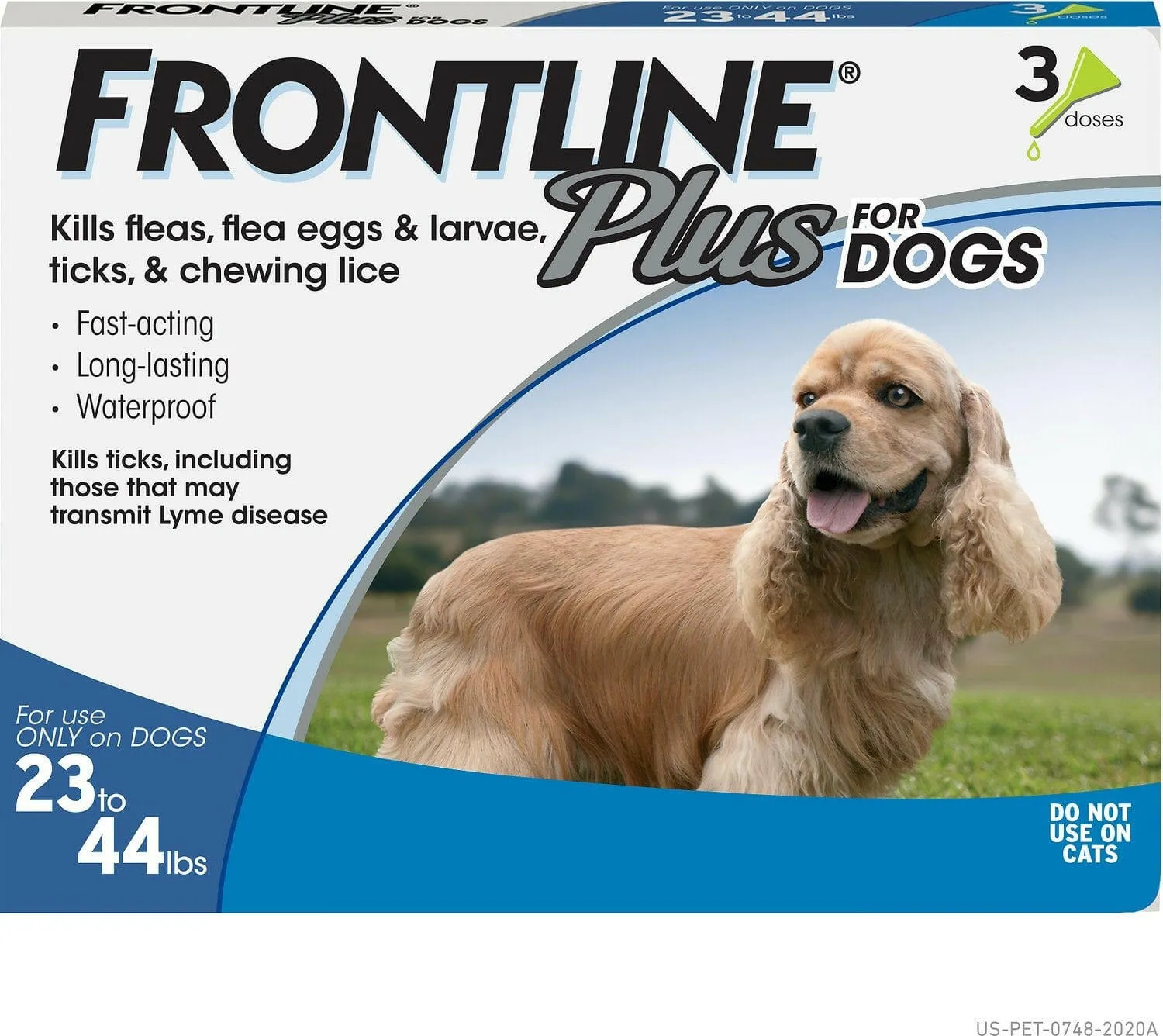 Frontline Plus for Medium Dogs, a trusted topical flea and tick treatment.
Frontline Plus for Medium Dogs, a trusted topical flea and tick treatment.
- Type: Topical
- Active Ingredients: Fipronil, (S)-methoprene
- Speed & Duration: Begins working within 4 hours, lasts 30 days.
- Pros: Kills adult fleas, larvae, eggs, and ticks; waterproof and easy to apply; widely trusted by vets and pet parents.
- Cons: Can leave a slightly oily residue post-application; may not be ideal for dogs with extremely sensitive skin.
- Best For: Reliable monthly protection across all breeds and general prevention against common parasites.
2. K9 Advantix II (Topical) — Multi-Threat Defense (Fleas, Ticks & Mosquitoes)
K9 Advantix II provides broad-spectrum protection, not only against fleas and ticks but also mosquitoes, offering an excellent solution for active outdoor dogs. This treatment helps prevent potential illnesses spread by multiple vectors.
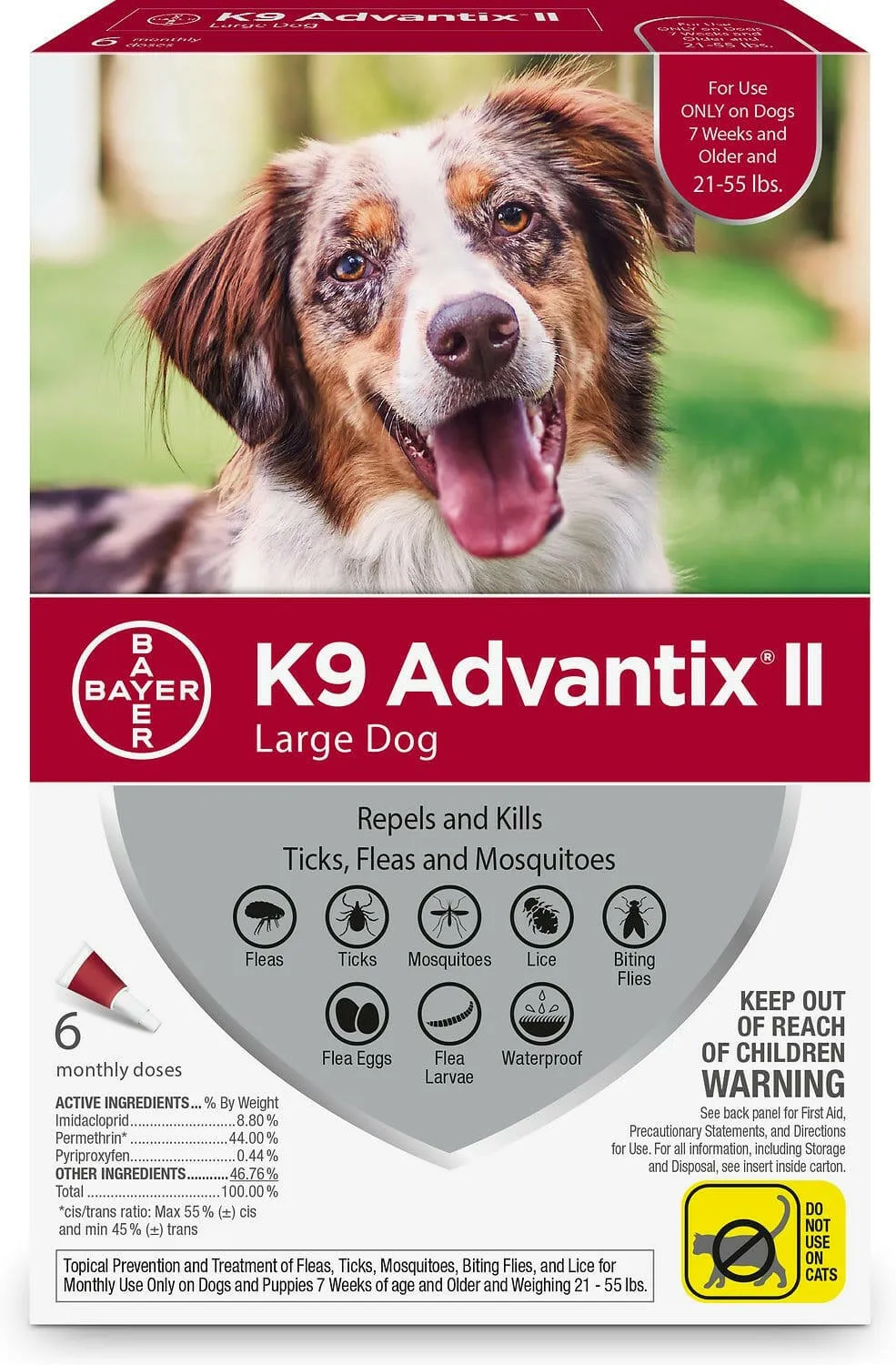 K9 Advantix II for Large Dogs in a red box, offering multi-parasite defense.
K9 Advantix II for Large Dogs in a red box, offering multi-parasite defense.
- Type: Topical
- Active Ingredients: Imidacloprid, Permethrin
- Speed & Duration: Kills on contact, protects for 30 days.
- Pros: Repels and kills fleas, ticks, and mosquitoes; quick absorption, so no flea bite is required for efficacy; offers affordable multi-parasite coverage.
- Cons: Not safe for cats—highly toxic due to permethrin; may irritate dogs with very sensitive skin.
- Best For: Outdoor dogs and active pets living in areas with high tick and mosquito populations.
3. Seresto Flea Collar — Longest-Lasting OTC Option
The Seresto Flea & Tick Collar is renowned for its extended efficacy, providing continuous protection for a significant period without the need for monthly applications. Its unique design releases active ingredients in controlled, low doses.
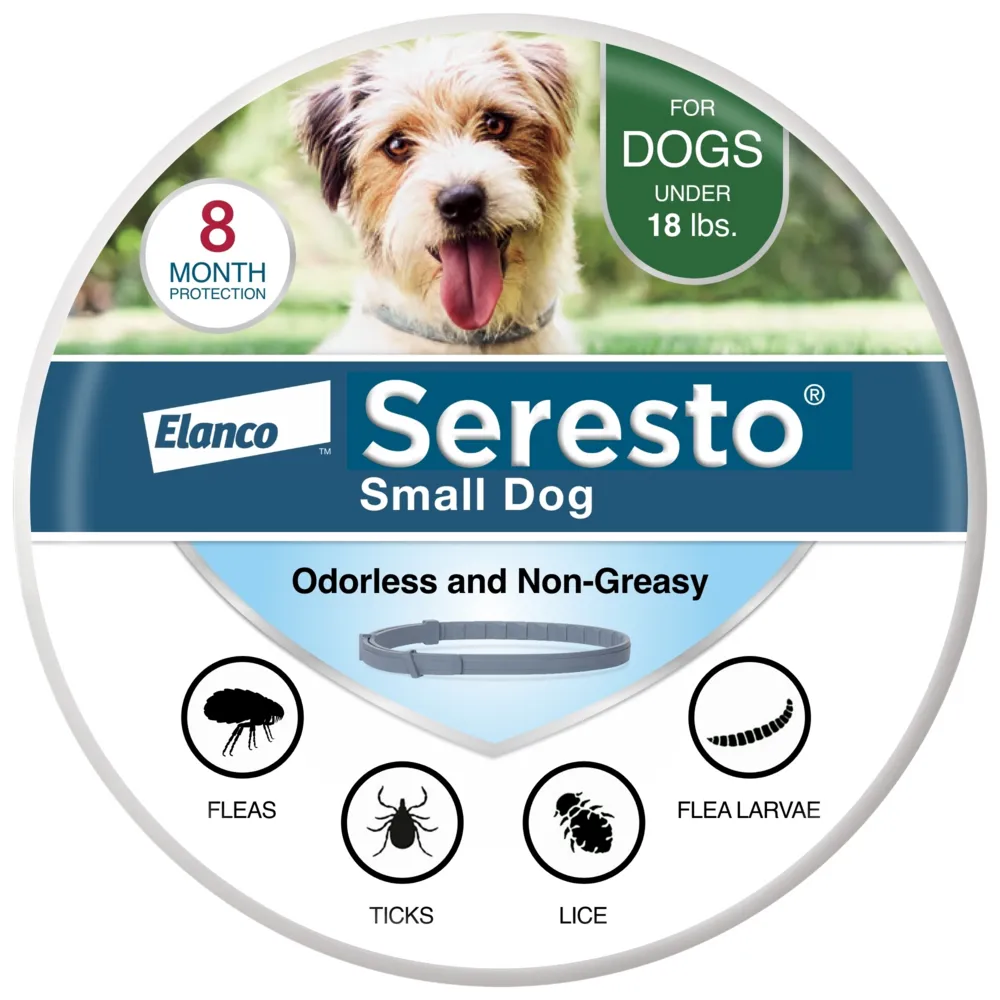 Seresto Flea and Tick Collar on a dog, designed for long-lasting protection.
Seresto Flea and Tick Collar on a dog, designed for long-lasting protection.
- Type: Collar
- Active Ingredients: Imidacloprid, Flumethrin
- Speed & Duration: Begins within 24 hours, lasts up to 8 months.
- Pros: Offers extended protection without monthly reapplication; non-greasy and odorless; water-resistant, allowing for normal pet activities.
- Cons: Higher initial cost compared to a single dose of other treatments; may cause mild skin irritation in rare cases around the neck area.
- Best For: Busy owners or dogs requiring year-round, low-maintenance protection from fleas and ticks.
4. Capstar (Oral Pill) — Instant Flea Kill for Emergencies
Capstar provides incredibly fast-acting relief, making it an essential tool for sudden and severe flea infestations where immediate kill is needed. Its oral format makes it convenient for many dog owners.
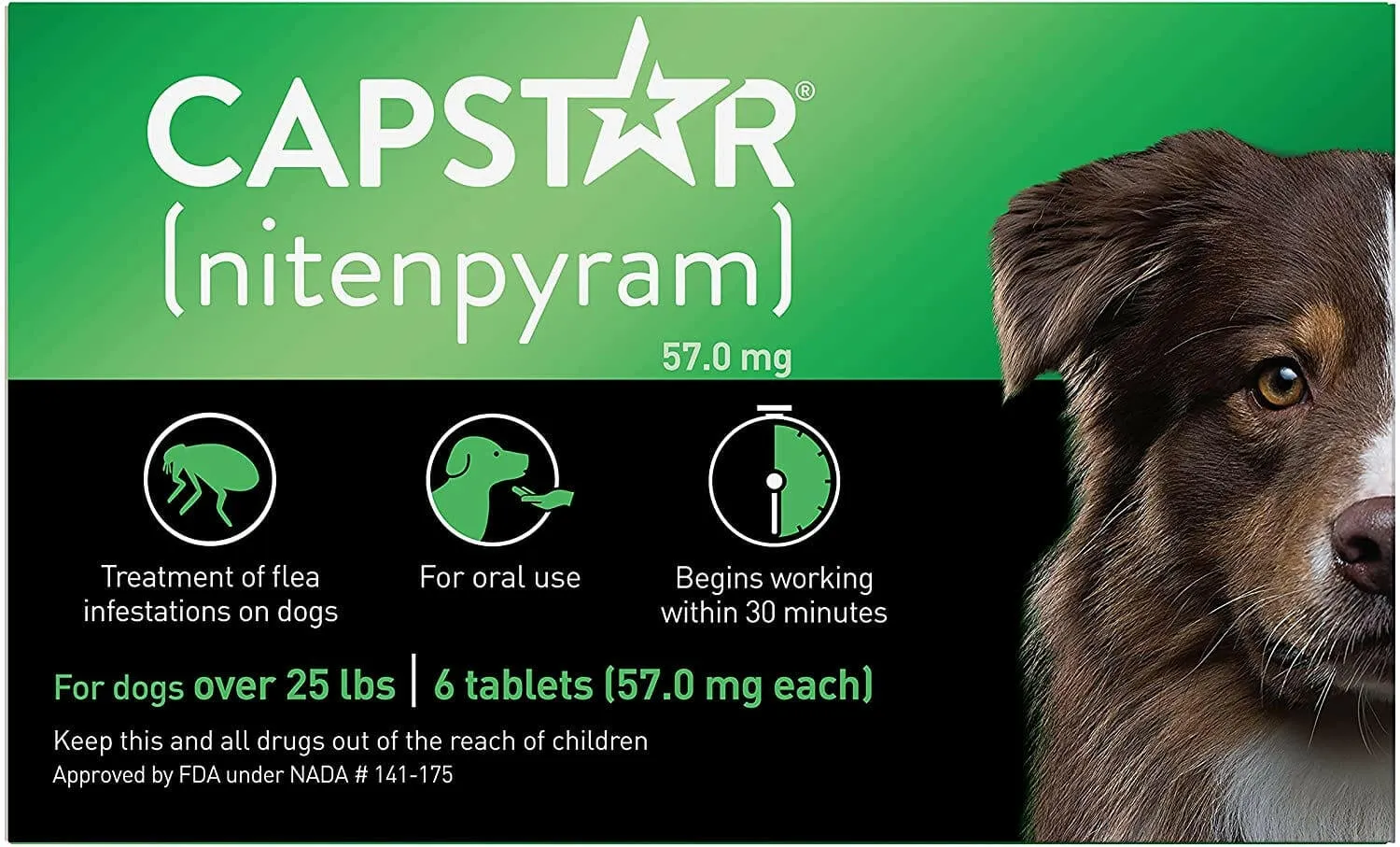 Capstar oral flea treatment for dogs over 25 lbs, designed for rapid action.
Capstar oral flea treatment for dogs over 25 lbs, designed for rapid action.
- Type: Oral Pill
- Active Ingredient: Nitenpyram
- Speed & Duration: Kills fleas within 30 minutes; effect lasts approximately 24 hours.
- Pros: Perfect for sudden infestations, offering immediate knockdown; safe for puppies over 2 lbs and 4 weeks old; no mess or residue left on the dog’s coat.
- Cons: Does not offer lasting protection against reinfestation; requires follow-up treatment with a longer-lasting product.
- Best For: Fast, emergency relief during severe flea flare-ups or before transitioning to a long-term preventative.
5. Advantage II (Topical) — Gentle Monthly Flea Control
Advantage II is a popular topical treatment known for its effectiveness against fleas at all life stages, and it’s a good choice for households with cats due to its formulation. It focuses specifically on flea eradication, providing targeted protection.
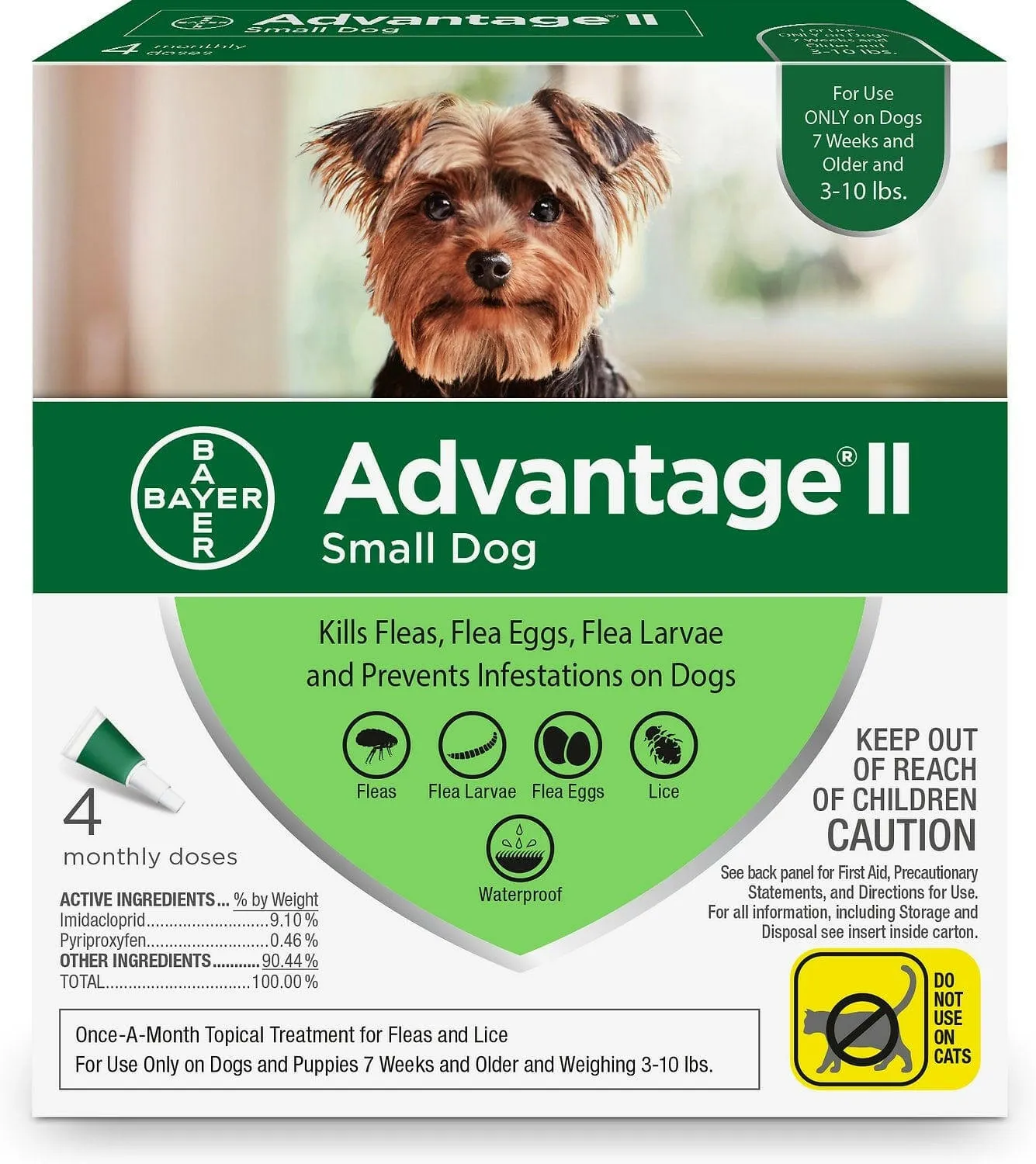 Advantage II flea control for small dogs, packaged in a green box.
Advantage II flea control for small dogs, packaged in a green box.
- Type: Topical
- Active Ingredients: Imidacloprid, Pyriproxyfen
- Speed & Duration: Kills within 12 hours, lasts 30 days.
- Pros: Fragrance-free and easy to apply; effective against flea eggs and larvae, breaking the life cycle; safe for households with cats once dry, as it doesn’t contain permethrin.
- Cons: Does not kill ticks, so additional protection may be needed in tick-prone areas; may require thorough brushing for dogs with very thick coats to ensure proper skin contact.
- Best For: Indoor dogs and pet owners in cat-friendly homes who need reliable monthly flea control.
6. Adams Plus Flea & Tick Shampoo — Flea Relief with Skin Care
Adams Plus Flea & Tick Shampoo offers a dual benefit: immediate flea and tick kill during bath time, combined with ingredients that soothe irritated skin. It’s a great option for initial parasite removal and providing comfort to a scratching dog.
 Adams Plus Flea & Tick Foaming Shampoo and Wash for Dogs & Puppies.
Adams Plus Flea & Tick Foaming Shampoo and Wash for Dogs & Puppies.
- Type: Shampoo
- Active Ingredients: Pyrethrins, Aloe, Lanolin
- Speed & Duration: Immediate effect during bath, short-term residual protection.
- Pros: Kills fleas, ticks, and lice on contact, providing rapid relief; soothes irritated skin with conditioning agents; affordable and widely available in most pet stores.
- Cons: Offers only a short-term solution and requires follow-up treatment; not suitable for puppies under 12 weeks of age.
- Best For: Bath-time flea removal, immediate relief from itching, and coat care for dogs with skin sensitivities.
Most of these top-rated treatments are readily available at HardyPaw.com, where you can find quality, safety, and value for your pet’s needs.
Choosing the Right Flea Medicine for Your Dog
With a vast array of flea products on the market, selecting the most appropriate one for your furry friend can feel overwhelming. A tailored approach, considering your dog’s individual needs and lifestyle, is key to successful flea control. Here’s a clear checklist to help you make the smartest choice:
- Your Dog’s Size and Weight: This is perhaps the most crucial factor. Almost all flea medications are precisely dosed based on your dog’s weight. Administering a treatment designed for a large breed to a smaller dog can lead to serious side effects, while an undersized dose might be ineffective. Always read the label meticulously and choose the product specifically formulated for your dog’s weight range.
- Age and Health Status: Puppies, pregnant dogs, senior pets, or those with underlying health conditions (such as liver or kidney disease) often require specially formulated or vet-approved treatments. For example, Capstar is safe for puppies over 4 weeks old and 2 lbs, but many topical treatments have an age restriction of 8 weeks or older. Always consult your vet if your dog falls into a high-risk category.
- Type of Infestation: Assess the severity of the flea problem. Is it a light seasonal issue, or a heavy, recurring infestation that requires immediate action? Capstar offers an instant kill for emergencies, providing rapid relief, while Seresto collars offer extended protection over several months for chronic cases or year-round prevention.
- Lifestyle & Environment: Consider where your dog spends its time. Active dogs that frequently spend time outdoors, especially in grassy or wooded areas, may benefit most from multi-threat options like K9 Advantix II, which also repels mosquitoes and ticks. Indoor-only dogs might only need a flea-specific preventative like Advantage II.
- Household Composition: If you have cats in your household, this is a critical consideration. Avoid dog flea treatments containing permethrin (such as K9 Advantix II), as this ingredient is highly toxic and potentially fatal to felines. Always ensure any product used is safe for all pets in your home, especially if they interact closely.
- Application Preference: Your personal preference for application can also guide your choice. Oral tablets like Capstar are ideal for a no-mess approach, topical spot-ons offer monthly ease of application, and collars provide a convenient “set-it-and-forget-it” option for long-term control. Consider what is easiest and most comfortable for both you and your dog.
How to Use Flea Medicine Safely Without a Prescription
The term “over-the-counter” does not imply “risk-free.” While OTC flea medicines are widely accessible and highly effective when used correctly, it is paramount to use them responsibly to safeguard your dog’s health. Incorrect usage can lead to adverse reactions or simply render the treatment ineffective. Here’s a detailed guide on how to administer these products safely and effectively:
- Always Read and Follow the Label Meticulously: Each product comes with specific usage instructions tailored to your dog’s size, age, and health status. Never guess the dose or application method. Adhere to the label exactly, as deviating from these guidelines can lead to under-dosing (ineffective) or over-dosing (dangerous).
- Use the Correct Product for Your Dog’s Weight and Age: This cannot be overstressed. Giving a large-dog product to a small pup—or vice versa—can lead to severe, even dangerous, side effects. Puppies, senior dogs, and those with pre-existing health conditions may have unique needs and might require vet-approved alternatives or specific formulations.
- Avoid Mixing Flea Products Unless Directed by a Vet: Do not use multiple flea treatments simultaneously (e.g., a topical spot-on concurrently with a flea collar) unless explicitly recommended by your veterinarian. Excessive exposure to active ingredients from various products can lead to an overdose and harmful reactions, even if the individual products are considered safe.
- Monitor Your Pet for Side Effects: After applying or administering any flea medication, closely observe your dog for any unusual behavior or physical symptoms. Watch for signs like excessive drooling, vomiting, shaking, lethargy, loss of appetite, or skin irritation at the application site. If any adverse symptoms appear, contact your vet immediately for guidance.
- Keep Other Pets in Mind (Especially Cats): Some dog flea products, particularly those containing permethrin, are highly toxic to cats. If you have a multi-pet household, ensure that cats do not come into contact with treated dogs until the product has fully dried. Separate pets if necessary and wash your hands thoroughly after application.
- Store Treatments Safely: Always store flea medications out of reach of all pets and children. Keep them in a cool, dry place as directed on the packaging to maintain their efficacy and prevent accidental ingestion.
- Stay Consistent with the Schedule: Administer or apply flea treatments precisely on schedule—whether that’s daily, monthly, or seasonally. Skipping doses can leave your pet vulnerable to reinfestation, allowing fleas to multiply and re-establish themselves in your home environment. Consistency is key to long-term control.
Used properly, over-the-counter flea medicine is a safe and effective tool in your pet care arsenal. For instance, knowing the best way to get dog to take pills can significantly improve compliance for oral flea treatments. Up next: how to support your flea treatment with proactive environmental care.
Beyond Medication: Holistic Flea Control
Treating your dog is a crucial first step, but it represents only one part of a truly effective flea elimination strategy. To fully eradicate fleas and prevent their return, you must also tackle their presence in your pet’s entire environment. Fleas spend most of their life cycle off the host, meaning your home and yard can harbor eggs, larvae, and pupae. Here are some proven tips that work synergistically with flea medications to create a flea-free zone:
- Groom Your Dog Regularly: Frequent brushing serves a dual purpose. It helps you spot fleas early, before an infestation takes hold, and it physically removes dead skin, flea dirt, and even some fleas and their eggs from your dog’s coat. Use a fine-toothed flea comb to target common problem areas like the neck, along the back, and at the base of the tail. This practice is also a great opportunity for bonding with your pet.
- Bathe Your Pet When Needed: Flea shampoos provide a quick knockdown effect, especially valuable during the initial stages of a heavy infestation. Even regular bathing with a mild, dog-specific shampoo can help keep fleas at bay by washing away some parasites and debris. Always follow the product instructions, and remember that shampoos offer immediate relief but usually not long-term protection.
- Clean Your Home Thoroughly: Your indoor environment is a prime breeding ground for fleas. Vacuum carpets, rugs, and furniture frequently, paying extra attention to areas where your dog rests or spends significant time. The vibrations from vacuuming can also encourage flea pupae to hatch, making them more susceptible to your treatment. Immediately dispose of vacuum bags outside your home. Wash all pet bedding in hot water (at least 140°F/60°C) at least once a week to destroy flea eggs and larvae.
- Treat Your Home and Yard: For moderate to severe infestations, treating your home and yard is indispensable. Use flea sprays, powders, or foggers specifically designed for indoor use, following label directions closely. Outdoors, keep your lawn trimmed short, remove leaf litter, and eliminate debris piles where fleas thrive. Consider using yard treatments in shaded, moist areas where fleas are most likely to be found.
- Use Flea Preventatives Year-Round: Many people mistakenly believe fleas are only a problem in summer. However, indoor heating can keep fleas active year-round, even in colder climates. Maintaining your chosen flea medication schedule consistently, even during winter months, is crucial to prevent reinfestation and break the flea life cycle.
- Limit Exposure to Untreated Pets: Fleas can easily “hitch a ride” from other animals. Try to avoid letting your dog play with pets that are not on a regular flea prevention plan. If you frequent dog parks or communal areas, be extra diligent with your own dog’s preventative measures.
By combining over-the-counter flea medicine with consistent and thorough home care, you dramatically reduce the chances of reinfestation, ensuring your dog remains comfortable, healthy, and protected from these pervasive parasites.
Are Over-the-Counter Flea Medicines Safe for Dogs?
Generally, most over-the-counter flea treatments are considered safe for dogs when used strictly according to their label instructions. However, like any medication, they carry the potential for side effects, especially if the dosage is incorrect, if the dog has specific sensitivities, or if products are mixed improperly. Understanding these potential risks and how to mitigate them is crucial for responsible pet ownership.
Common Side Effects
While rare, some dogs may experience mild reactions to flea treatments:
- Topical Treatments: The most common reactions include skin irritation, redness, itching, or temporary hair loss at the application site. Some dogs may also show signs of lethargy or restlessness.
- Oral Medications: Less common side effects can include mild gastrointestinal upset such as vomiting, diarrhea, or a temporary decrease in appetite.
- Flea Collars: Mild itchiness or discomfort around the neck area is occasionally reported as the dog adjusts to the collar.
Always prioritize selecting a product appropriate for your dog’s specific weight and age. For instance, many topical flea treatments are not safe for puppies under 8 weeks of age, and using them on very young animals can lead to toxicity.
Special Precautions
Several critical precautions must be observed to ensure safety:
- Never use cat flea products on dogs, or vice versa. This is a non-negotiable rule. Ingredients common in dog flea treatments, particularly permethrin, are highly toxic and often fatal to cats. Similarly, some cat products may not be effective or safe for dogs.
- Avoid mixing treatments unless explicitly directed by a veterinarian. Combining a topical spot-on with a flea collar, or using multiple oral treatments, can lead to an overdose of active ingredients, resulting in severe adverse reactions.
- Monitor your dog closely after the first use of any new product. Watch for any unusual behavior, such as excessive scratching, lethargy, disorientation, or vomiting. If you observe any concerning symptoms, contact your veterinarian immediately. Early intervention can prevent more serious complications.
When Should You See a Vet Even If Using OTC Flea Products?
While over-the-counter flea medicines are highly effective for prevention and managing mild to moderate infestations, there are specific situations where professional veterinary care becomes absolutely essential. Recognizing these scenarios is vital for your dog’s health and well-being.
- Severe Infestations That Don’t Improve: If fleas persist or keep returning despite several rounds of consistent OTC treatment and environmental cleaning, it might signal a resistant flea strain or a hidden, ongoing environmental source of infestation. A veterinarian can prescribe stronger, prescription-grade treatments or combination therapies to effectively break the tenacious flea life cycle.
- Signs of Allergic Reactions or Side Effects: Watch carefully for symptoms such as excessive drooling, vomiting, diarrhea, tremors, significant skin irritation (beyond mild redness), or pronounced behavioral changes after applying any flea medication. These could indicate an adverse reaction to the product that requires immediate veterinary attention.
- Flea-Borne Illnesses or Secondary Infections: Fleas are not just pests; they can transmit diseases like tapeworms and cause secondary bacterial skin infections due to constant scratching. If your dog is experiencing hair loss, developing scabs, has open sores, seems lethargic, or shows signs of general illness, do not delay—a vet visit is crucial for diagnosis and appropriate treatment. Conditions like heartworm, while not flea-borne, also require veterinary intervention and prevention, making regular check-ups vital. For serious parasite concerns, discuss options like heartworm medicine with your vet.
- High-Risk Pets (Puppies, Seniors, Pregnant Dogs, or Chronically Ill Dogs): These sensitive groups may not tolerate standard OTC treatments well due to their delicate physiology or compromised immune systems. Puppies, elderly dogs, pregnant or lactating females, and dogs with chronic illnesses often require customized, lower-dose, or prescription-strength solutions to ensure their safety and efficacy.
- You’re Unsure What Product to Choose or How to Apply It: If you feel overwhelmed by the vast array of choices or are uncertain about which product is safest and most effective for your dog’s specific needs and health status, a quick consultation with your veterinarian can save you time, money, and significant stress. They can offer personalized recommendations and guidance.
Remember: OTC flea medicine is an excellent tool for many situations, but your veterinarian remains your best and most reliable resource for complex cases, severe infestations, or pets with unique health sensitivities.
Final Thoughts on Choosing Flea Medicines Without a Vet Prescription
Fleas are far more than just a minor inconvenience; they pose a significant health risk to your cherished dog and can become a persistent headache for pet owners. Fortunately, the availability of effective over-the-counter flea medicines empowers you to fight back against these parasites without always requiring a vet prescription. Whether your preference is for a convenient monthly topical application, a fast-acting oral pill for immediate relief, or a long-lasting collar for extended protection, there are numerous effective and affordable options available to suit every lifestyle and situation.
However, the real key to long-term success in flea control goes beyond simply selecting the right product. It fundamentally hinges on using that product correctly, maintaining strict consistency with its application schedule, and diligently combining medication with proactive, smart home hygiene practices. Every single step counts in this battle—from regular grooming and thorough house cleaning to diligent yard care and unwavering year-round prevention. A holistic approach ensures you tackle fleas at every stage of their life cycle, both on your pet and in their environment.
And always remember—while over-the-counter solutions are powerful and accessible tools, your veterinarian is an invaluable resource and always just a call away if an infestation proves overwhelming, if your dog exhibits adverse reactions, or if they have special health needs that require tailored advice. With the right strategy, combined with a little help from trusted retailers like HardyPaw, your dog can continue to live a happy, healthy, and consistently flea-free life all year long.
OTC Flea Medicine for Dogs FAQs
Can I use flea medicine for dogs on puppies under 8 weeks old?
No, the majority of OTC flea medicines are explicitly not safe for puppies under 8 weeks of age. Always verify the specific age and weight requirements listed on the product label. Administering treatment to very young dogs against these guidelines can lead to toxicity or severe adverse reactions. If you have a young puppy with fleas, consult your veterinarian for safe and appropriate treatment options.
What should I do if my dog licks the flea treatment?
If your dog manages to lick a topical flea product, monitor them closely for any signs of adverse reaction such as excessive drooling, vomiting, lethargy, or behavioral changes. Many topical treatments contain bittering agents to deter licking, but ingestion can still cause mild side effects. Contact your veterinarian promptly for guidance, providing them with the specific product name and active ingredients.
How long after applying flea medicine can I bathe my dog?
Most topical flea treatments require a waiting period of 24 to 48 hours after application before bathing. This timeframe allows the product to fully absorb into your dog’s skin and spread effectively, ensuring maximum efficacy. Bathing too soon can wash away the active ingredients and significantly reduce the product’s effectiveness. Always refer to the specific product’s instructions for the exact recommended wait time.
Can I use OTC flea treatments year-round?
Yes, year-round flea prevention is highly recommended, especially if you live in a warmer climate or in a home with central heating. Fleas are incredibly resilient and can survive indoors even during colder winter months. Continuous protection helps to effectively prevent reinfestation, breaking the flea life cycle and maintaining a consistently flea-free environment for your pet.
What if my dog has fleas but no itching?
Fleas do not always cause immediate or visible discomfort in all dogs. Some dogs are less sensitive to flea bites, or the infestation might be very mild initially. However, even if your dog isn’t scratching, a flea infestation can still lead to other health issues like anemia, tapeworm transmission, or eventually, more noticeable skin irritation. If you spot fleas or flea dirt, it is crucial to treat immediately, even in the absence of itching signs. Regular checks of your dog’s fur and skin are key to early detection.
